Difference between Microeconomics and Macroeconomics
VerifiedAdded on 2022/12/14
|8
|1730
|381
AI Summary
Microeconomics and macroeconomics are two main branches of economics that study individual economic agents and the economy as a whole respectively.
Contribute Materials
Your contribution can guide someone’s learning journey. Share your
documents today.
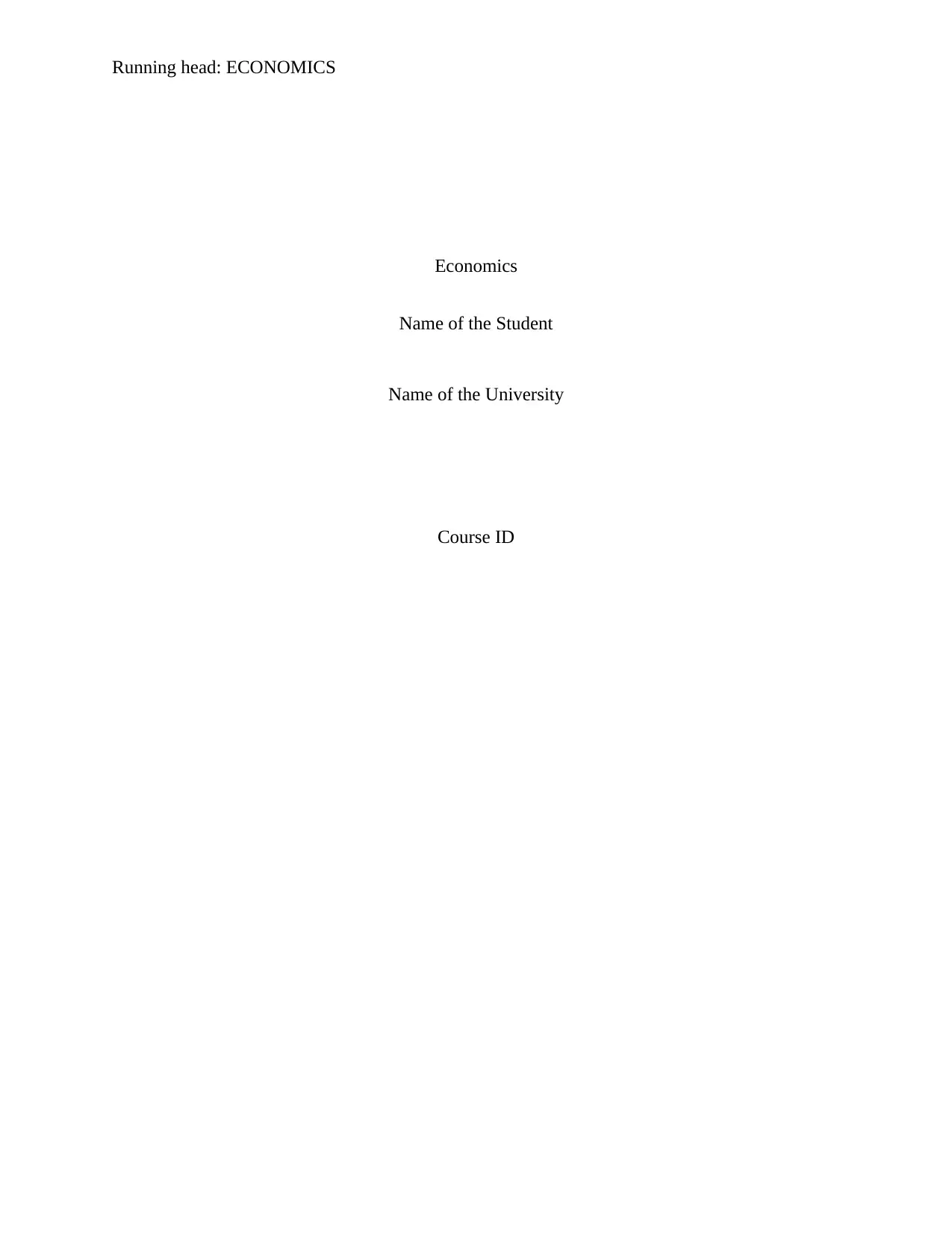
Running head: ECONOMICS
Economics
Name of the Student
Name of the University
Course ID
Economics
Name of the Student
Name of the University
Course ID
Secure Best Marks with AI Grader
Need help grading? Try our AI Grader for instant feedback on your assignments.
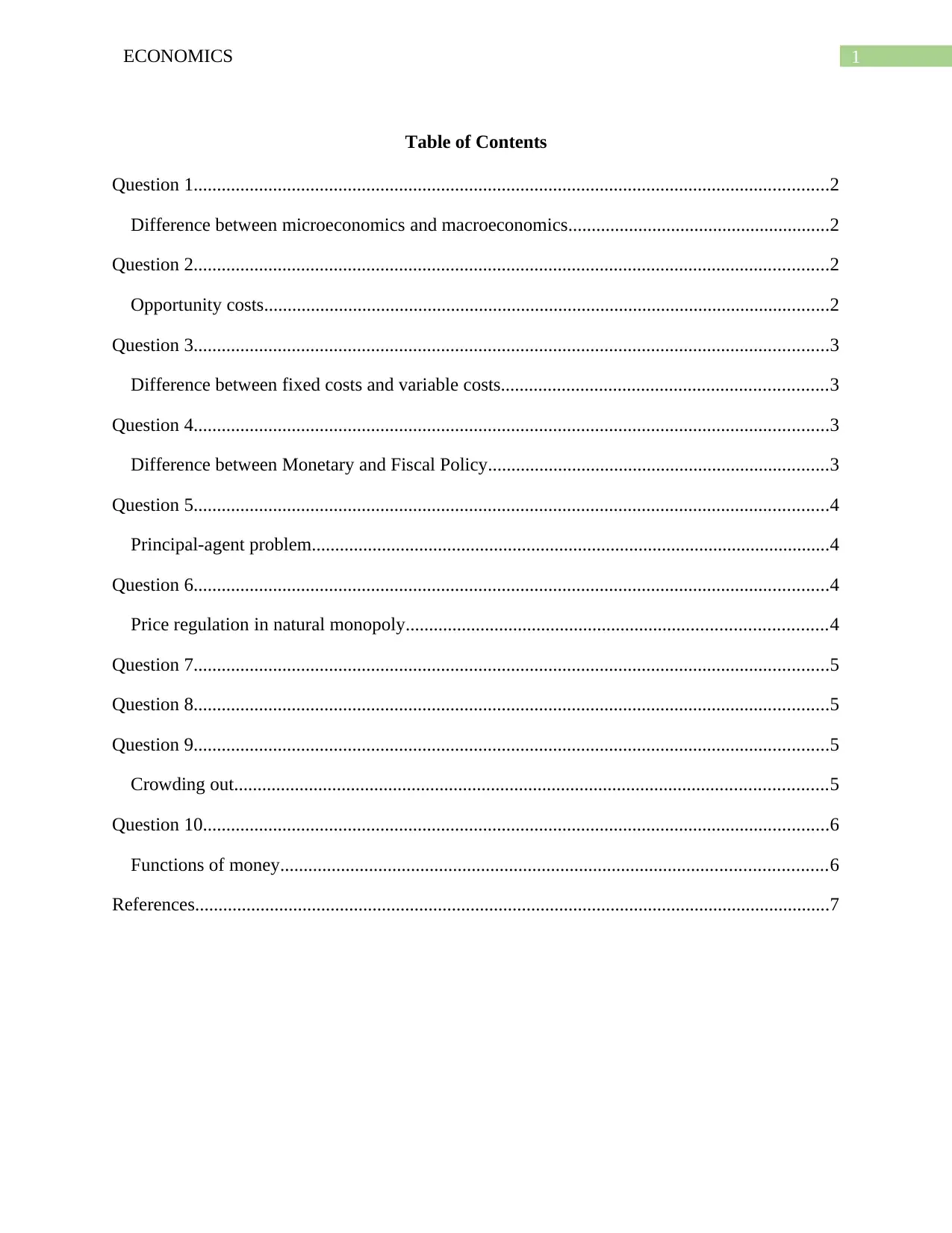
1ECONOMICS
Table of Contents
Question 1........................................................................................................................................2
Difference between microeconomics and macroeconomics........................................................2
Question 2........................................................................................................................................2
Opportunity costs.........................................................................................................................2
Question 3........................................................................................................................................3
Difference between fixed costs and variable costs......................................................................3
Question 4........................................................................................................................................3
Difference between Monetary and Fiscal Policy.........................................................................3
Question 5........................................................................................................................................4
Principal-agent problem...............................................................................................................4
Question 6........................................................................................................................................4
Price regulation in natural monopoly..........................................................................................4
Question 7........................................................................................................................................5
Question 8........................................................................................................................................5
Question 9........................................................................................................................................5
Crowding out...............................................................................................................................5
Question 10......................................................................................................................................6
Functions of money.....................................................................................................................6
References........................................................................................................................................7
Table of Contents
Question 1........................................................................................................................................2
Difference between microeconomics and macroeconomics........................................................2
Question 2........................................................................................................................................2
Opportunity costs.........................................................................................................................2
Question 3........................................................................................................................................3
Difference between fixed costs and variable costs......................................................................3
Question 4........................................................................................................................................3
Difference between Monetary and Fiscal Policy.........................................................................3
Question 5........................................................................................................................................4
Principal-agent problem...............................................................................................................4
Question 6........................................................................................................................................4
Price regulation in natural monopoly..........................................................................................4
Question 7........................................................................................................................................5
Question 8........................................................................................................................................5
Question 9........................................................................................................................................5
Crowding out...............................................................................................................................5
Question 10......................................................................................................................................6
Functions of money.....................................................................................................................6
References........................................................................................................................................7
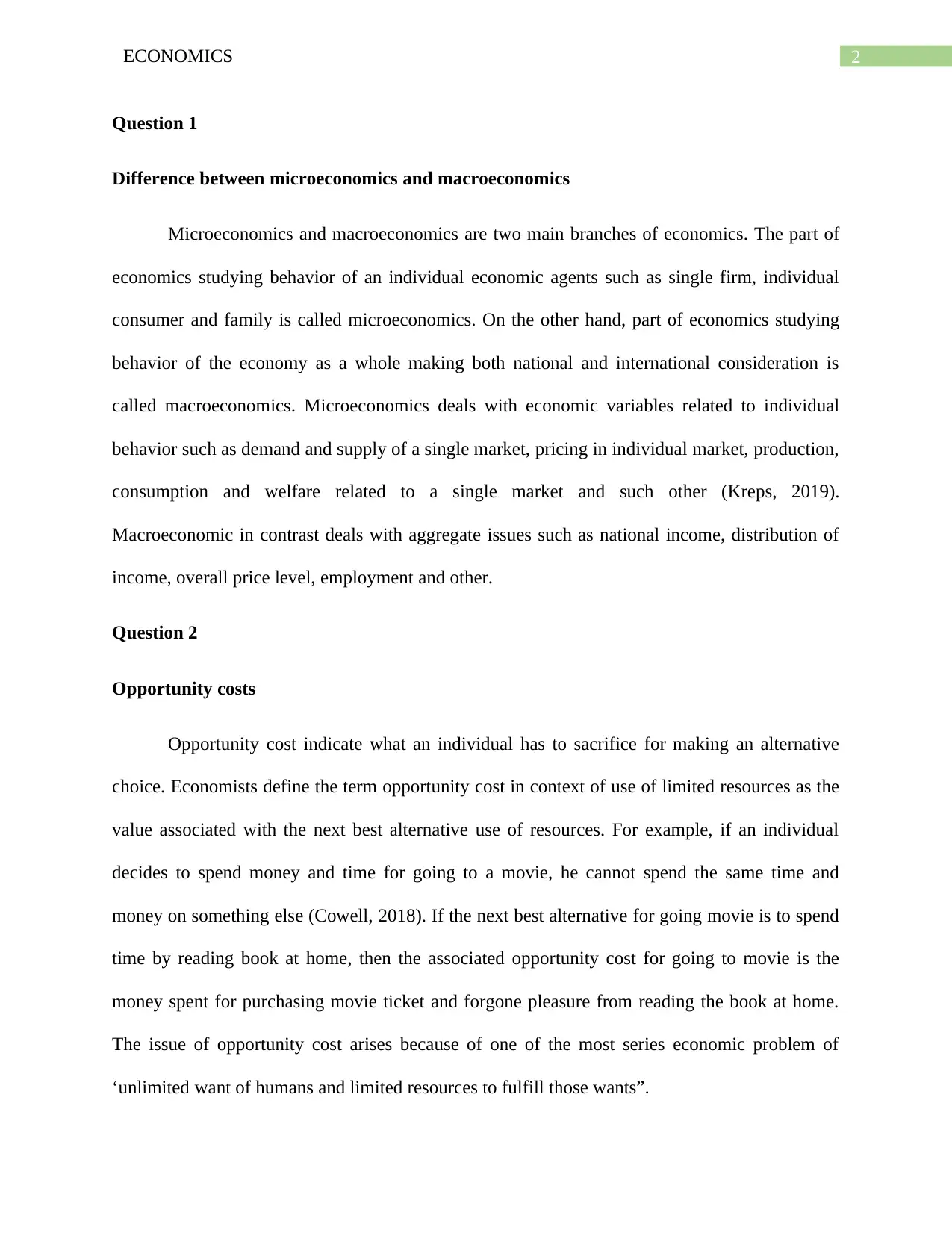
2ECONOMICS
Question 1
Difference between microeconomics and macroeconomics
Microeconomics and macroeconomics are two main branches of economics. The part of
economics studying behavior of an individual economic agents such as single firm, individual
consumer and family is called microeconomics. On the other hand, part of economics studying
behavior of the economy as a whole making both national and international consideration is
called macroeconomics. Microeconomics deals with economic variables related to individual
behavior such as demand and supply of a single market, pricing in individual market, production,
consumption and welfare related to a single market and such other (Kreps, 2019).
Macroeconomic in contrast deals with aggregate issues such as national income, distribution of
income, overall price level, employment and other.
Question 2
Opportunity costs
Opportunity cost indicate what an individual has to sacrifice for making an alternative
choice. Economists define the term opportunity cost in context of use of limited resources as the
value associated with the next best alternative use of resources. For example, if an individual
decides to spend money and time for going to a movie, he cannot spend the same time and
money on something else (Cowell, 2018). If the next best alternative for going movie is to spend
time by reading book at home, then the associated opportunity cost for going to movie is the
money spent for purchasing movie ticket and forgone pleasure from reading the book at home.
The issue of opportunity cost arises because of one of the most series economic problem of
‘unlimited want of humans and limited resources to fulfill those wants”.
Question 1
Difference between microeconomics and macroeconomics
Microeconomics and macroeconomics are two main branches of economics. The part of
economics studying behavior of an individual economic agents such as single firm, individual
consumer and family is called microeconomics. On the other hand, part of economics studying
behavior of the economy as a whole making both national and international consideration is
called macroeconomics. Microeconomics deals with economic variables related to individual
behavior such as demand and supply of a single market, pricing in individual market, production,
consumption and welfare related to a single market and such other (Kreps, 2019).
Macroeconomic in contrast deals with aggregate issues such as national income, distribution of
income, overall price level, employment and other.
Question 2
Opportunity costs
Opportunity cost indicate what an individual has to sacrifice for making an alternative
choice. Economists define the term opportunity cost in context of use of limited resources as the
value associated with the next best alternative use of resources. For example, if an individual
decides to spend money and time for going to a movie, he cannot spend the same time and
money on something else (Cowell, 2018). If the next best alternative for going movie is to spend
time by reading book at home, then the associated opportunity cost for going to movie is the
money spent for purchasing movie ticket and forgone pleasure from reading the book at home.
The issue of opportunity cost arises because of one of the most series economic problem of
‘unlimited want of humans and limited resources to fulfill those wants”.
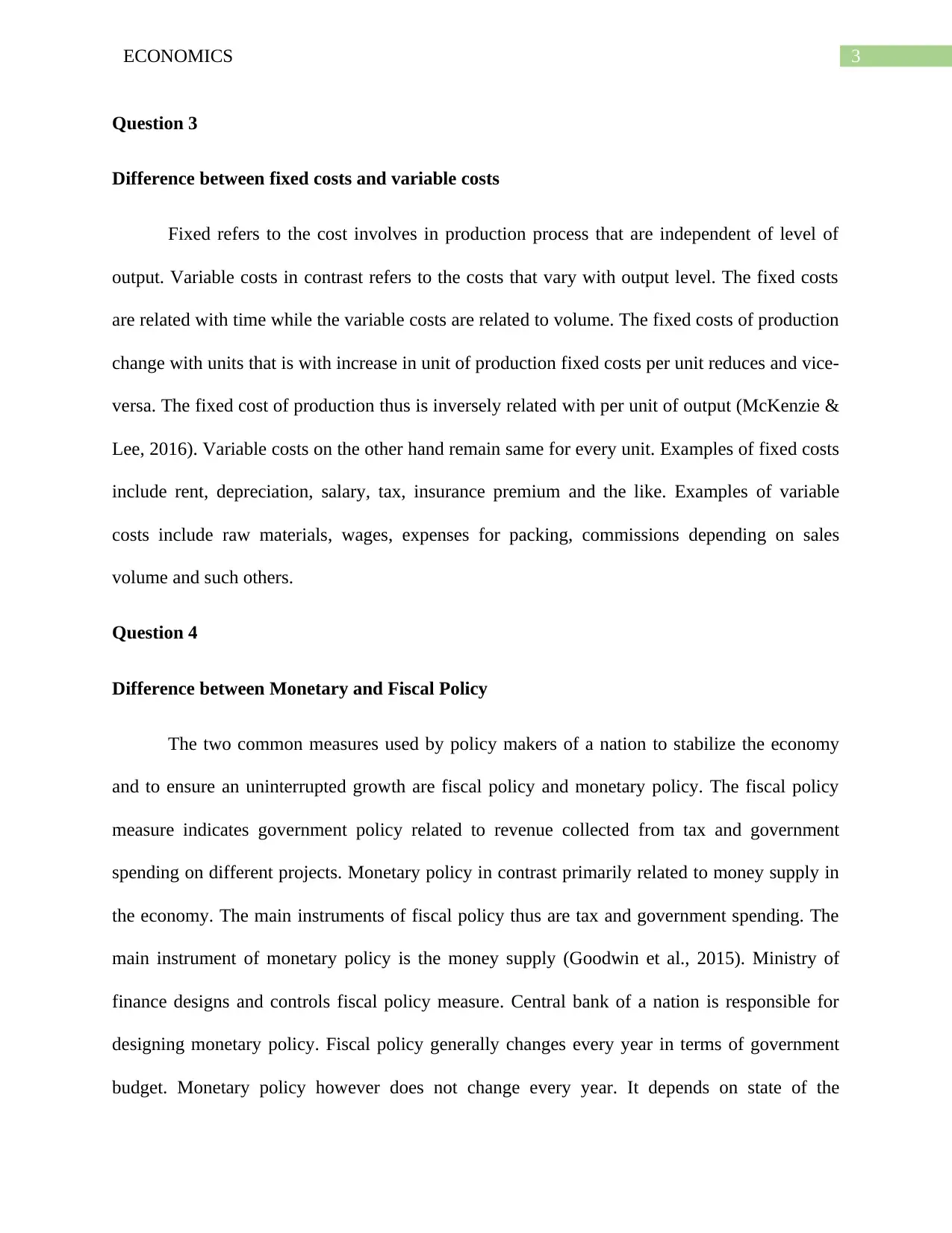
3ECONOMICS
Question 3
Difference between fixed costs and variable costs
Fixed refers to the cost involves in production process that are independent of level of
output. Variable costs in contrast refers to the costs that vary with output level. The fixed costs
are related with time while the variable costs are related to volume. The fixed costs of production
change with units that is with increase in unit of production fixed costs per unit reduces and vice-
versa. The fixed cost of production thus is inversely related with per unit of output (McKenzie &
Lee, 2016). Variable costs on the other hand remain same for every unit. Examples of fixed costs
include rent, depreciation, salary, tax, insurance premium and the like. Examples of variable
costs include raw materials, wages, expenses for packing, commissions depending on sales
volume and such others.
Question 4
Difference between Monetary and Fiscal Policy
The two common measures used by policy makers of a nation to stabilize the economy
and to ensure an uninterrupted growth are fiscal policy and monetary policy. The fiscal policy
measure indicates government policy related to revenue collected from tax and government
spending on different projects. Monetary policy in contrast primarily related to money supply in
the economy. The main instruments of fiscal policy thus are tax and government spending. The
main instrument of monetary policy is the money supply (Goodwin et al., 2015). Ministry of
finance designs and controls fiscal policy measure. Central bank of a nation is responsible for
designing monetary policy. Fiscal policy generally changes every year in terms of government
budget. Monetary policy however does not change every year. It depends on state of the
Question 3
Difference between fixed costs and variable costs
Fixed refers to the cost involves in production process that are independent of level of
output. Variable costs in contrast refers to the costs that vary with output level. The fixed costs
are related with time while the variable costs are related to volume. The fixed costs of production
change with units that is with increase in unit of production fixed costs per unit reduces and vice-
versa. The fixed cost of production thus is inversely related with per unit of output (McKenzie &
Lee, 2016). Variable costs on the other hand remain same for every unit. Examples of fixed costs
include rent, depreciation, salary, tax, insurance premium and the like. Examples of variable
costs include raw materials, wages, expenses for packing, commissions depending on sales
volume and such others.
Question 4
Difference between Monetary and Fiscal Policy
The two common measures used by policy makers of a nation to stabilize the economy
and to ensure an uninterrupted growth are fiscal policy and monetary policy. The fiscal policy
measure indicates government policy related to revenue collected from tax and government
spending on different projects. Monetary policy in contrast primarily related to money supply in
the economy. The main instruments of fiscal policy thus are tax and government spending. The
main instrument of monetary policy is the money supply (Goodwin et al., 2015). Ministry of
finance designs and controls fiscal policy measure. Central bank of a nation is responsible for
designing monetary policy. Fiscal policy generally changes every year in terms of government
budget. Monetary policy however does not change every year. It depends on state of the
Secure Best Marks with AI Grader
Need help grading? Try our AI Grader for instant feedback on your assignments.
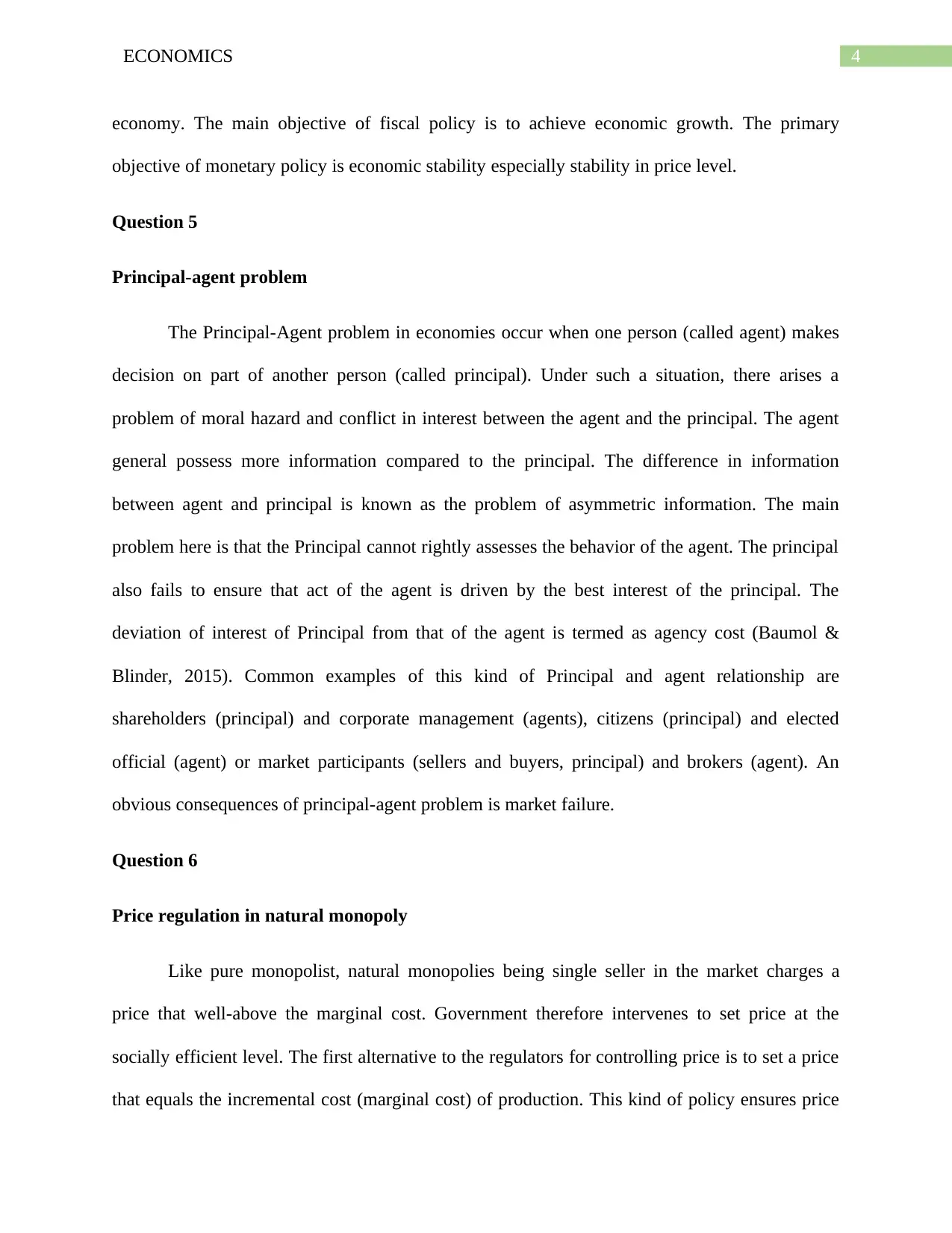
4ECONOMICS
economy. The main objective of fiscal policy is to achieve economic growth. The primary
objective of monetary policy is economic stability especially stability in price level.
Question 5
Principal-agent problem
The Principal-Agent problem in economies occur when one person (called agent) makes
decision on part of another person (called principal). Under such a situation, there arises a
problem of moral hazard and conflict in interest between the agent and the principal. The agent
general possess more information compared to the principal. The difference in information
between agent and principal is known as the problem of asymmetric information. The main
problem here is that the Principal cannot rightly assesses the behavior of the agent. The principal
also fails to ensure that act of the agent is driven by the best interest of the principal. The
deviation of interest of Principal from that of the agent is termed as agency cost (Baumol &
Blinder, 2015). Common examples of this kind of Principal and agent relationship are
shareholders (principal) and corporate management (agents), citizens (principal) and elected
official (agent) or market participants (sellers and buyers, principal) and brokers (agent). An
obvious consequences of principal-agent problem is market failure.
Question 6
Price regulation in natural monopoly
Like pure monopolist, natural monopolies being single seller in the market charges a
price that well-above the marginal cost. Government therefore intervenes to set price at the
socially efficient level. The first alternative to the regulators for controlling price is to set a price
that equals the incremental cost (marginal cost) of production. This kind of policy ensures price
economy. The main objective of fiscal policy is to achieve economic growth. The primary
objective of monetary policy is economic stability especially stability in price level.
Question 5
Principal-agent problem
The Principal-Agent problem in economies occur when one person (called agent) makes
decision on part of another person (called principal). Under such a situation, there arises a
problem of moral hazard and conflict in interest between the agent and the principal. The agent
general possess more information compared to the principal. The difference in information
between agent and principal is known as the problem of asymmetric information. The main
problem here is that the Principal cannot rightly assesses the behavior of the agent. The principal
also fails to ensure that act of the agent is driven by the best interest of the principal. The
deviation of interest of Principal from that of the agent is termed as agency cost (Baumol &
Blinder, 2015). Common examples of this kind of Principal and agent relationship are
shareholders (principal) and corporate management (agents), citizens (principal) and elected
official (agent) or market participants (sellers and buyers, principal) and brokers (agent). An
obvious consequences of principal-agent problem is market failure.
Question 6
Price regulation in natural monopoly
Like pure monopolist, natural monopolies being single seller in the market charges a
price that well-above the marginal cost. Government therefore intervenes to set price at the
socially efficient level. The first alternative to the regulators for controlling price is to set a price
that equals the incremental cost (marginal cost) of production. This kind of policy ensures price
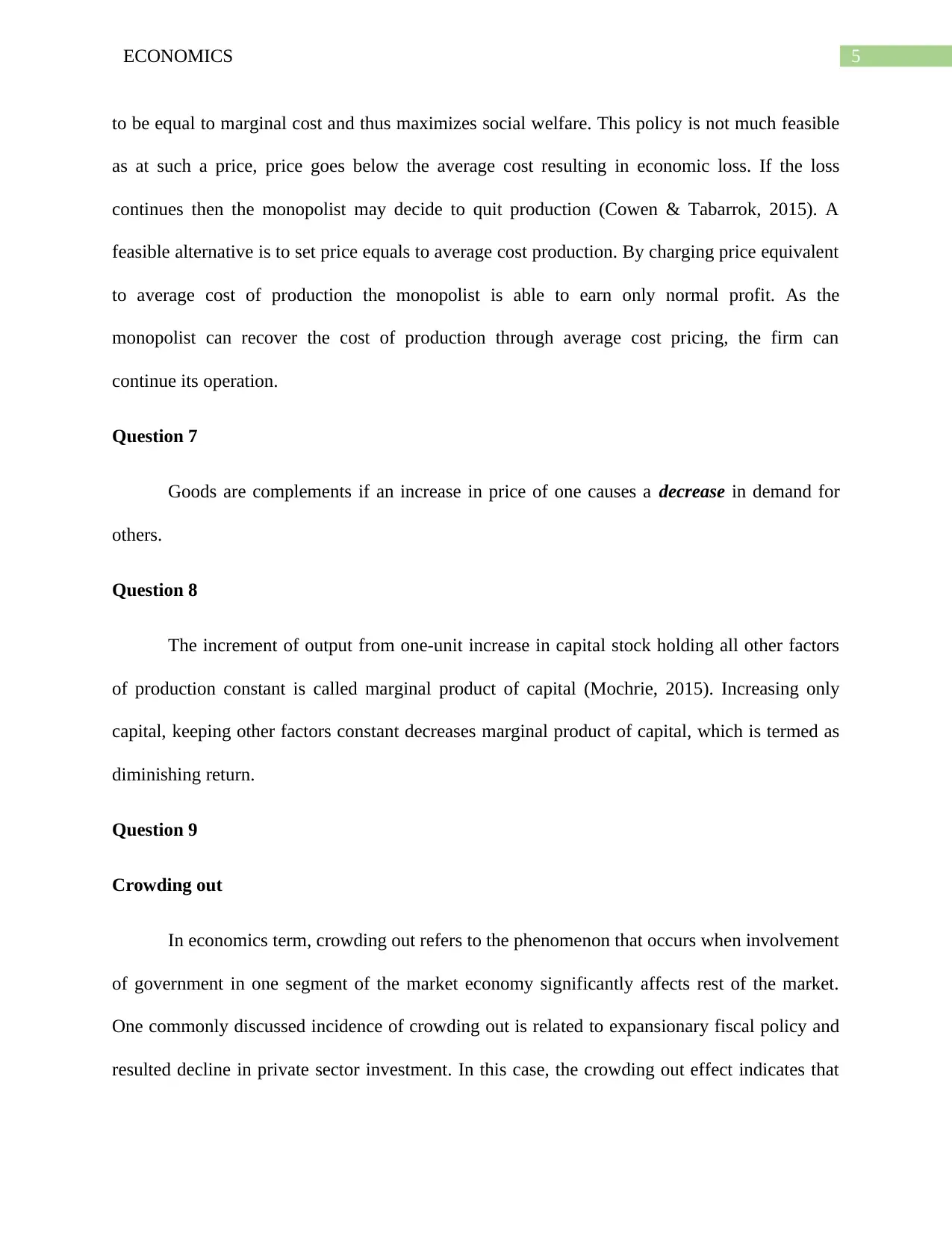
5ECONOMICS
to be equal to marginal cost and thus maximizes social welfare. This policy is not much feasible
as at such a price, price goes below the average cost resulting in economic loss. If the loss
continues then the monopolist may decide to quit production (Cowen & Tabarrok, 2015). A
feasible alternative is to set price equals to average cost production. By charging price equivalent
to average cost of production the monopolist is able to earn only normal profit. As the
monopolist can recover the cost of production through average cost pricing, the firm can
continue its operation.
Question 7
Goods are complements if an increase in price of one causes a decrease in demand for
others.
Question 8
The increment of output from one-unit increase in capital stock holding all other factors
of production constant is called marginal product of capital (Mochrie, 2015). Increasing only
capital, keeping other factors constant decreases marginal product of capital, which is termed as
diminishing return.
Question 9
Crowding out
In economics term, crowding out refers to the phenomenon that occurs when involvement
of government in one segment of the market economy significantly affects rest of the market.
One commonly discussed incidence of crowding out is related to expansionary fiscal policy and
resulted decline in private sector investment. In this case, the crowding out effect indicates that
to be equal to marginal cost and thus maximizes social welfare. This policy is not much feasible
as at such a price, price goes below the average cost resulting in economic loss. If the loss
continues then the monopolist may decide to quit production (Cowen & Tabarrok, 2015). A
feasible alternative is to set price equals to average cost production. By charging price equivalent
to average cost of production the monopolist is able to earn only normal profit. As the
monopolist can recover the cost of production through average cost pricing, the firm can
continue its operation.
Question 7
Goods are complements if an increase in price of one causes a decrease in demand for
others.
Question 8
The increment of output from one-unit increase in capital stock holding all other factors
of production constant is called marginal product of capital (Mochrie, 2015). Increasing only
capital, keeping other factors constant decreases marginal product of capital, which is termed as
diminishing return.
Question 9
Crowding out
In economics term, crowding out refers to the phenomenon that occurs when involvement
of government in one segment of the market economy significantly affects rest of the market.
One commonly discussed incidence of crowding out is related to expansionary fiscal policy and
resulted decline in private sector investment. In this case, the crowding out effect indicates that
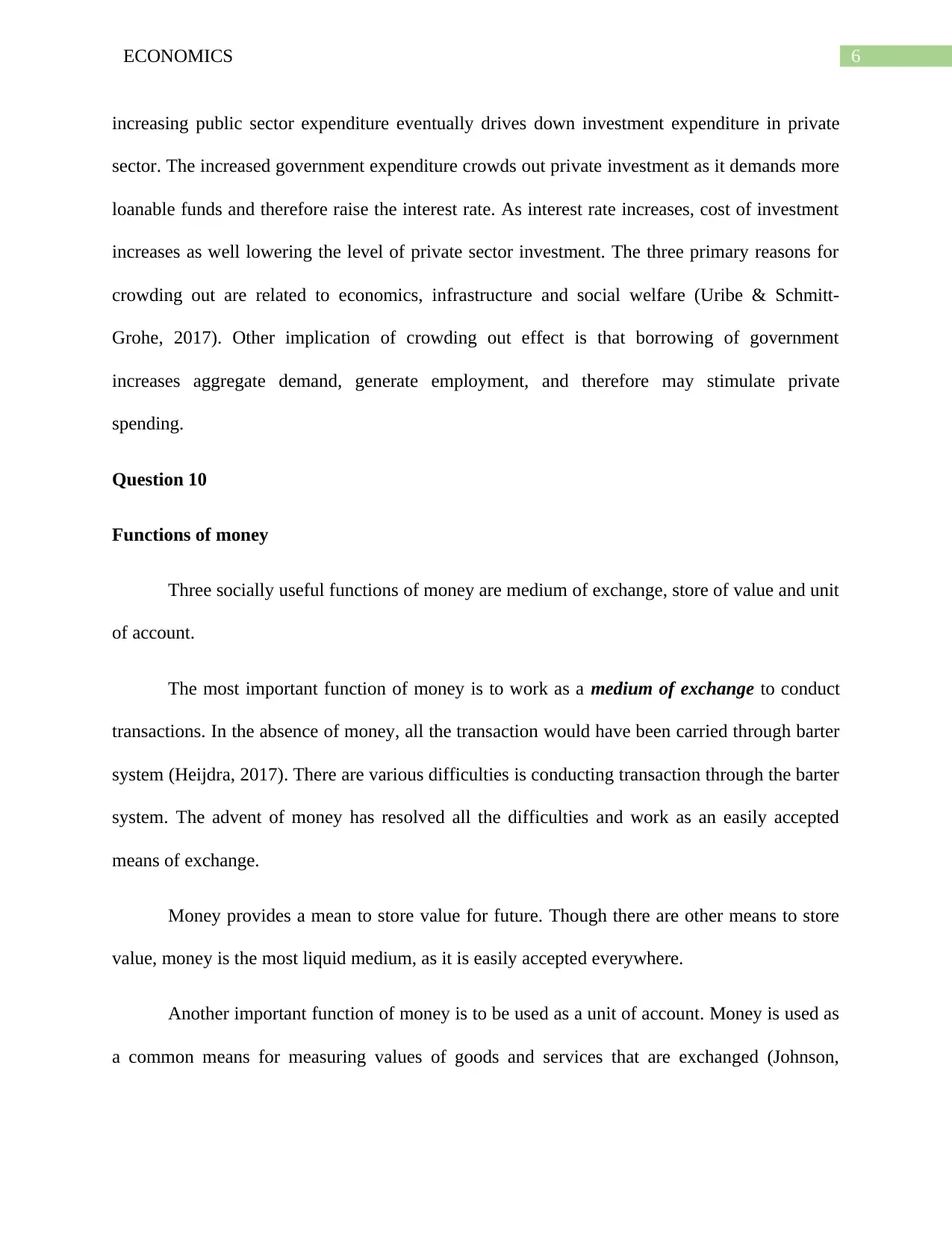
6ECONOMICS
increasing public sector expenditure eventually drives down investment expenditure in private
sector. The increased government expenditure crowds out private investment as it demands more
loanable funds and therefore raise the interest rate. As interest rate increases, cost of investment
increases as well lowering the level of private sector investment. The three primary reasons for
crowding out are related to economics, infrastructure and social welfare (Uribe & Schmitt-
Grohe, 2017). Other implication of crowding out effect is that borrowing of government
increases aggregate demand, generate employment, and therefore may stimulate private
spending.
Question 10
Functions of money
Three socially useful functions of money are medium of exchange, store of value and unit
of account.
The most important function of money is to work as a medium of exchange to conduct
transactions. In the absence of money, all the transaction would have been carried through barter
system (Heijdra, 2017). There are various difficulties is conducting transaction through the barter
system. The advent of money has resolved all the difficulties and work as an easily accepted
means of exchange.
Money provides a mean to store value for future. Though there are other means to store
value, money is the most liquid medium, as it is easily accepted everywhere.
Another important function of money is to be used as a unit of account. Money is used as
a common means for measuring values of goods and services that are exchanged (Johnson,
increasing public sector expenditure eventually drives down investment expenditure in private
sector. The increased government expenditure crowds out private investment as it demands more
loanable funds and therefore raise the interest rate. As interest rate increases, cost of investment
increases as well lowering the level of private sector investment. The three primary reasons for
crowding out are related to economics, infrastructure and social welfare (Uribe & Schmitt-
Grohe, 2017). Other implication of crowding out effect is that borrowing of government
increases aggregate demand, generate employment, and therefore may stimulate private
spending.
Question 10
Functions of money
Three socially useful functions of money are medium of exchange, store of value and unit
of account.
The most important function of money is to work as a medium of exchange to conduct
transactions. In the absence of money, all the transaction would have been carried through barter
system (Heijdra, 2017). There are various difficulties is conducting transaction through the barter
system. The advent of money has resolved all the difficulties and work as an easily accepted
means of exchange.
Money provides a mean to store value for future. Though there are other means to store
value, money is the most liquid medium, as it is easily accepted everywhere.
Another important function of money is to be used as a unit of account. Money is used as
a common means for measuring values of goods and services that are exchanged (Johnson,
Paraphrase This Document
Need a fresh take? Get an instant paraphrase of this document with our AI Paraphraser
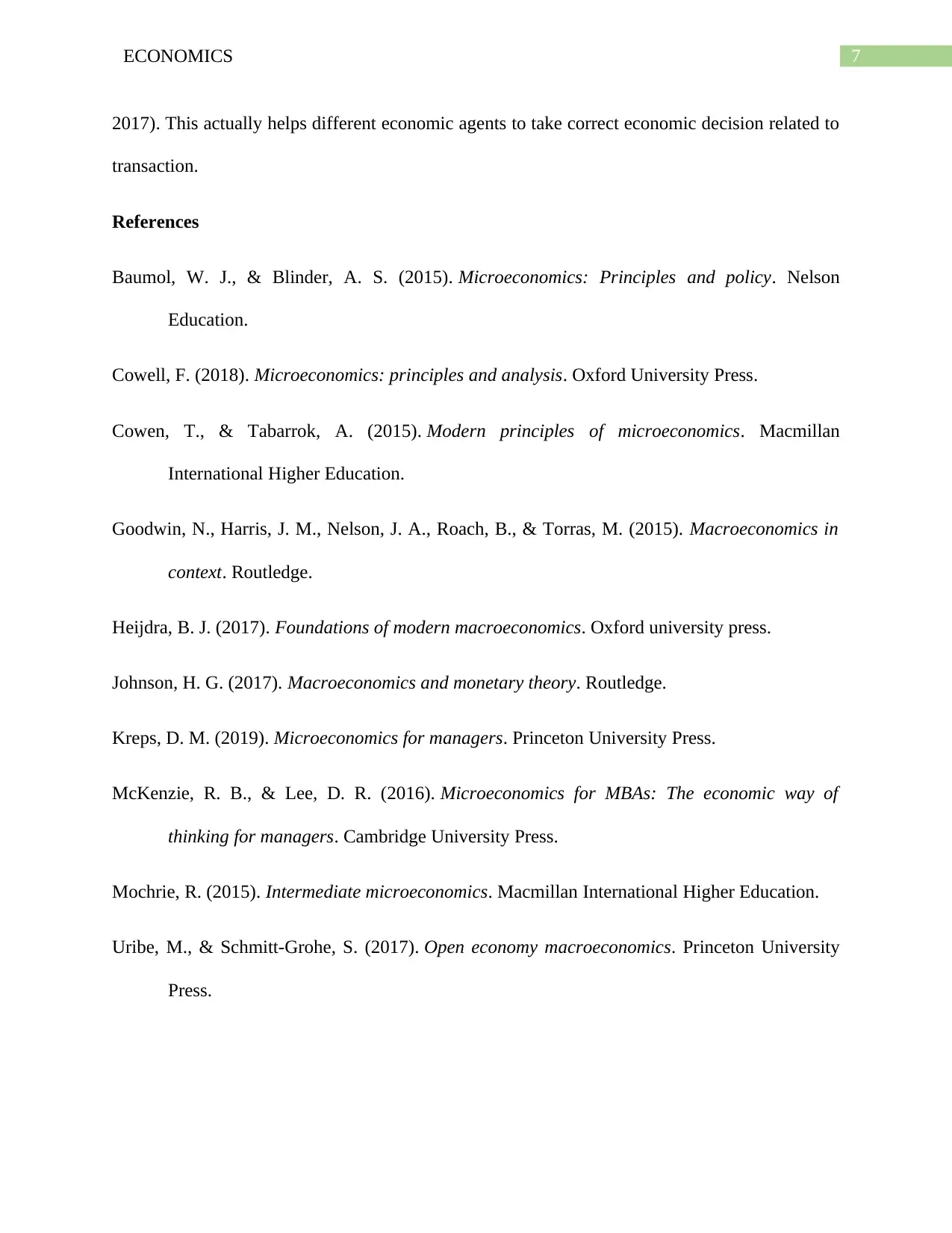
7ECONOMICS
2017). This actually helps different economic agents to take correct economic decision related to
transaction.
References
Baumol, W. J., & Blinder, A. S. (2015). Microeconomics: Principles and policy. Nelson
Education.
Cowell, F. (2018). Microeconomics: principles and analysis. Oxford University Press.
Cowen, T., & Tabarrok, A. (2015). Modern principles of microeconomics. Macmillan
International Higher Education.
Goodwin, N., Harris, J. M., Nelson, J. A., Roach, B., & Torras, M. (2015). Macroeconomics in
context. Routledge.
Heijdra, B. J. (2017). Foundations of modern macroeconomics. Oxford university press.
Johnson, H. G. (2017). Macroeconomics and monetary theory. Routledge.
Kreps, D. M. (2019). Microeconomics for managers. Princeton University Press.
McKenzie, R. B., & Lee, D. R. (2016). Microeconomics for MBAs: The economic way of
thinking for managers. Cambridge University Press.
Mochrie, R. (2015). Intermediate microeconomics. Macmillan International Higher Education.
Uribe, M., & Schmitt-Grohe, S. (2017). Open economy macroeconomics. Princeton University
Press.
2017). This actually helps different economic agents to take correct economic decision related to
transaction.
References
Baumol, W. J., & Blinder, A. S. (2015). Microeconomics: Principles and policy. Nelson
Education.
Cowell, F. (2018). Microeconomics: principles and analysis. Oxford University Press.
Cowen, T., & Tabarrok, A. (2015). Modern principles of microeconomics. Macmillan
International Higher Education.
Goodwin, N., Harris, J. M., Nelson, J. A., Roach, B., & Torras, M. (2015). Macroeconomics in
context. Routledge.
Heijdra, B. J. (2017). Foundations of modern macroeconomics. Oxford university press.
Johnson, H. G. (2017). Macroeconomics and monetary theory. Routledge.
Kreps, D. M. (2019). Microeconomics for managers. Princeton University Press.
McKenzie, R. B., & Lee, D. R. (2016). Microeconomics for MBAs: The economic way of
thinking for managers. Cambridge University Press.
Mochrie, R. (2015). Intermediate microeconomics. Macmillan International Higher Education.
Uribe, M., & Schmitt-Grohe, S. (2017). Open economy macroeconomics. Princeton University
Press.
1 out of 8
Related Documents
Your All-in-One AI-Powered Toolkit for Academic Success.
+13062052269
info@desklib.com
Available 24*7 on WhatsApp / Email
![[object Object]](/_next/static/media/star-bottom.7253800d.svg)
Unlock your academic potential
© 2024 | Zucol Services PVT LTD | All rights reserved.

